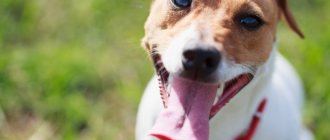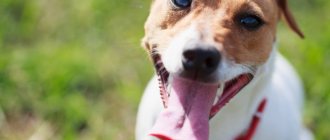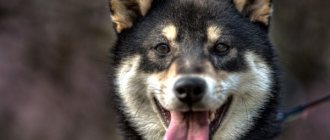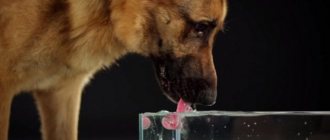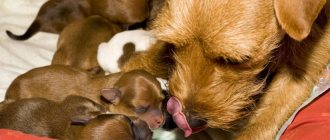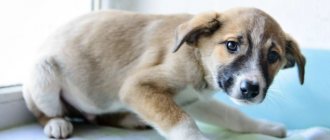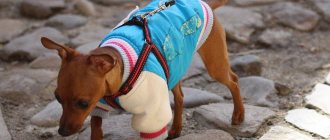An adult dog usually breathes with its mouth closed and takes 10-30 breaths per minute. Their number depends on the individual characteristics of the pet. As a rule, bitches, puppies and small breed dogs with a faster metabolism breathe more often. Frequent breathing can also be caused by psychological reasons, such as stress or overexcitement. But why can a calm dog breathe frequently and heavily with its mouth open?
Why does my dog often breathe with his mouth open?
The cause of rapid breathing can be both physiological characteristics and pathologies. This is absolutely normal if the dog is breathing frequently due to physiological changes in its body, which are associated with the need to speed up metabolism and metabolism.
Why does a dog often breathe with its mouth open?
- Such changes include excitement. That is, the dog is scared or, conversely, happy. In this case, it is quite normal for her to breathe frequently and stick out her tongue.
- After a long run or other physical activity, perhaps competition, the dog may also pant and stick out its tongue.
- Dogs in heat, like women on their period, feel a little strange and not very good.
- Blood pressure and temperature may increase. Therefore, rapid breathing during pregnancy, childbirth, and estrus is absolutely normal. High ambient temperature.
A pet
Specifics of dog treatment
Animal lovers should always remember that when a dog has rapid breathing, this is not an independent illness. Dyspnea is usually a clinical sign of the disease. It is quite clear that a course of therapy in this case is prescribed only after the cause of such pathology has been identified.
If the airway is obstructed, the doctor will remove the foreign object, perform artificial ventilation, or resort to tracheal intubation. When such a condition is associated with cardiac dysfunction, special therapy is indicated. For problems with the lungs, anti-inflammatory drugs and diuretics will be used for treatment.
In general, the therapeutic effect in identifying the causes of this complex pathology involves the following actions:
- hospitalization if necessary, keep the dog under an oxygen mask;
- prescribing medications to reduce stress;
- removing fluid between the lungs and the chest wall using a special thin needle;
- the use of diuretics - even ordinary Furosemide will have its due
- exposure to severe pulmonary edema;
- when necessary, use of drugs to support the heart.
Therapy at home
Hospitalization is carried out when there is an immediate threat to the life of the animal. In other cases, dogs are treated at home. For home therapy to be successful, owners of sick pets must adhere to certain recommendations:
- do not prevent the dog from drinking water - the administration of the same Furosemide can lead to dehydration of the animal’s body;
- do not violate the recommendations and instructions of the veterinarian - bring your pet for examination as often as you can;
- never buy, or even give your dog, medications that have not been prescribed by a doctor - the consequences of such independence can be very disastrous.
When your pet develops rapid breathing after sterilization or other surgical intervention, do not hesitate to consult a veterinarian about this - this may be a consequence of anesthesia, or it may be the first sign of any complication.
The dog is breathing quickly and is hot: reasons
However, if your dog is in a calm state, not nervous, it’s a cold season outside, but still often breathes with its mouth open, perhaps the reasons are pathological and indicate serious illnesses.
The dog is breathing quickly, hot, reasons:
- Entry of foreign bodies into the respiratory tract. This may be a neoplasm that narrows the lumen in the bronchi and lungs, blockage, or the ingress of foreign bodies. There may be fur or small objects in the bronchi.
- Inflammatory diseases of the respiratory organs . They can be of either infectious or viral origin. Dogs also suffer from bronchitis and pneumonia, as well as viral illnesses that can cause pneumonia.
- Respiratory damage due to trauma.
- Diseases of the cardiovascular system . The heart pumps blood throughout the body, therefore, due to pathologies of the cardiovascular system, respiratory diseases can be observed.
- Broken ribs, damaged bones. Broken ribs make it difficult to breathe normally. Note the dents in the chest area. There are usually other symptoms, such as the dog's weakness, pain when pressed, and restlessness.
- When the body temperature is elevated, the dog also breathes frequently . Pay attention to this to see if your pet is sick.
- Endocrine system diseases and allergies . If you have an allergic reaction, especially to pollen or food, your dog may also sneeze and pant.
Rapid breathing
Prevention of illness
Compliance with the rules and regulations for keeping him will help prevent the development of such a pathology in your four-legged friend. For example, lung diseases, as a rule, arise due to an infectious lesion of the body and it does not matter whether it is a direct pathology or the result of a complication of another ailment.
Therefore, protecting your pet from infectious agents is the main principle of preventing respiratory diseases. Therefore, it is always important: to adhere to regular examination of the pet, both by the owner himself (identifying various changes), and clinically, which will determine the pathology if something happens; at the slightest suspicion, perform an analysis for infectious lesions;
- do not refuse preventive vaccinations against diseases common in the region;
- Once a quarter, and in the summer much more often, treat against helminths.
Creating optimal conditions for keeping a pet is considered equally important. After all, inflammation of the respiratory system more often occurs in dogs that are kept in drafts, in cold, damp rooms. In this case, in the fall, especially their guard breeds, begin to cough heavily.
Spring is no less dangerous for animals, when allergic reactions can worsen against the background of plant pollen or poplar fluff. So if rapid breathing occurs in dogs, the causes should be looked for immediately and try to eliminate them. But when the owner himself cannot solve the problem, there is a reason to immediately seek veterinary help. It is important to always remember that there is no serious canine pathology that causes wheezing that can be treated at home.
Why does a dog breathe frequently after giving birth?
Particular attention should be paid to a dog who has recently become a mother. The fact is that the birth of puppies is a serious stress for the body, which can cause the development of certain ailments.
Why does a dog breathe frequently after giving birth:
- It is generally accepted that increased breathing during childbirth and 15 minutes after it is physiological, since it is during this period that the body needs a lot of oxygen. In the first 15 minutes after the birth of the first baby, it is necessary for the dog to produce a large amount of milk.
- It is at this moment that a lot of milk arrives in the mammary glands, and the amount of oxytocin and other sex hormones increases in the blood. All this is necessary for the birth to end safely, and for the girl to be able to give birth not only to puppies, but also to a placenta.
- If rapid breathing occurs for longer than 15 minutes, try palpating your pet's abdomen. Perhaps the rapid breathing is due to the fact that not all puppies were born. This happens if the first babies are stillborn. Perhaps labor has stopped and one or two puppies remain in the belly. You can easily determine this by palpating the lower abdomen.
Cute dog
My dog is breathing frequently after giving birth, what should I do?
But there are also pathological causes of rapid breathing after childbirth, especially they are observed the next day or a few days later. The fact is that almost all the body’s energy reserves during this period are spent on babies, that is, milk.
The dog is breathing frequently after giving birth, what to do:
- In order to produce it in sufficient quantities, the mother’s body is literally emptied; there is no calcium or glucose left in it. That is why a decent proportion of females after childbirth are faced with a disease such as eclampsia.
- Take a close look at your pet; if, along with rapid breathing, the paws stretch out, become as if wooden, or the female cannot rise on her hind legs, limps, drags them along with her, this is a reason to urgently go to the doctor.
- It is best if you purchase a solution of glucose and calcium gluconate in advance to give the necessary injection. There are drugs that are administered intramuscularly, usually injected into the dog's thigh. The amount of product is selected depending on the weight of the pet.
A pet
The dog is breathing heavily and frequently, what should I do?
Quite often, the cause of heavy breathing in a dog is heart problems. They usually appear in dogs over 8 years of age. Indeed, mature dogs can suffer from cardiovascular diseases.
The dog is breathing heavily and frequently, what to do:
- While walking, running, or active games, the dog gets tired very quickly and sticks out its tongue. Take a closer look at the color of the tongue. If it is blue, the dog most likely has heart problems. However, it is also necessary to pay attention to how the pet behaves.
- The accompanying symptoms can tell a lot. If this is an infectious disease, the dog may tremble, its performance decreases, and any desire to have fun, walk or run disappears.
- If previously your pet happily enjoyed a walk in the park and chased abandoned sticks, now he is very lethargic, trying to go into the shade and lie down. In this case, you need to pay attention to his breathing and body temperature.
- If you fed your dog unusual food, perhaps he picked up something on the street, after which rapid breathing, vomiting and diarrhea appeared, this indicates poisoning. It is necessary to rinse the dog’s stomach and give several tablets of activated carbon.
- The injury is difficult to miss; most often it manifests itself as damage to the skin, or uncharacteristic changes in the contours of the body. What usually happens with closed rib fractures.
On a walk
First aid for breathing problems
First aid for breathing problems in a dog directly depends on whether you understand the cause of the condition. If you have the slightest doubt about your own skills, take your dog to the vet immediately. To help your pet, try to calm him down as much as possible. The main thing is not to panic, because the dog senses your feelings and worries even more.
If the dog's breathing is erratic, the chest moves intermittently and without tact, a rhythmic massage of the sternum will help. If there is excessive saliva, remove it from the mouth with a napkin or palm. If your dog has difficulty breathing when lying down, help him get up, spread his front paws as far as possible, tilt his head forward and force his mouth open.
Why does my dog pant and whine frequently?
Frequent breathing, which is characterized by wheezing, whistling, and shallow breathing, indicates that the dog is sick with a viral or bacterial disease. She has pneumonia or bronchitis. Usually a whistling, short sound is heard when exhaling. Very often, before these symptoms, the dog experiences nasal discharge. Most likely, pneumonia is provoked by an exacerbation and deterioration in health after a viral infection.
Why does a dog pant and whine frequently?
- Frequent breathing can be caused by parasites. Oddly enough, infection with worms affects not only the state of the dog’s digestive system, but also the functioning of a large number of organs.
- The fact is that some types of worms live not only in the gastrointestinal tract. Some of them live in the dog's lungs. Therefore, parasites can provoke coughing, sneezing, and rapid breathing.
- Wheezing may be heard and symptoms similar to bronchitis may be observed. However, most often, infection with worms is not accompanied by a high temperature. Usually all vital signs are normal, but the dog becomes lethargic and may wheeze.
- In this case, you need to consult a doctor and be examined for worms. Much attention should be paid to this if you switched from artificial food to natural food and gave your dog raw meat.
At the doctor's appointment
How to eliminate chills in your dog yourself
Sometimes it is difficult to determine the cause of chills in a dog; you need to try to analyze the pet’s well-being, remember the events of the past days that could have affected the pet’s condition. A high temperature indicates possible infectious diseases or diseases of the internal organs.
If hypothermia is suspected, the dog should be warmed with a blanket or heating pad. To prevent the dog from freezing during walks in winter, he needs to wear special clothes. After home water treatments, the dog's fur should be thoroughly dried using a towel or hair dryer.
First aid for a hypoglycemic attack in an animal is to raise the glucose level, for this you can use honey (if there is no allergy), lubricate the gums with it or place it under the tongue every 6 hours until the trembling subsides or until veterinary intervention.
In case of poisoning, the dog requires gastric lavage, taking an absorbent, and drinking plenty of fluids. Allergy symptoms are suppressed with antihistamines. A frightened dog can be calmed down by a walk, a calm voice, the creation of familiar conditions, and eliminating the cause of anxiety.
Complex cases require a mandatory examination of the pet by a veterinarian. Only timely correct treatment will lead to a favorable outcome.
Why does a pregnant dog pant rapidly?
A dog's pregnancy can cause rapid breathing. This symptom appears around 57-60 days of pregnancy.
Why does a pregnant dog breathe frequently?
- This suggests that the dog is really preparing for childbirth, perhaps she is having contractions.
- Along with rapid breathing, other symptoms may also occur, such as licking a loop, tension in the lower abdomen.
- This all indicates the beginning of labor.
Journey
The dog breathes rapidly, sticks out its tongue and trembles
Owners of small dogs, such as the Yorkshire Terrier, often experience rapid breathing. Most often, such dogs are kept as a home pillow or toy.
The dog breathes frequently with its tongue hanging out and trembles:
- Therefore, they receive very little attention. The main task of the owners in this case is to feed and groom the dog. However, it is worth remembering that this dog also needs frequent walks and muscle training.
- Therefore, it is necessary to walk them as often as large breeds of dogs. That is three times a day. It is advisable to do this not for 10 minutes, but much longer, so that the dog can run properly and tense his muscles.
- It is precisely because many owners keep such dogs in greenhouse conditions that they often go to the toilet in the diaper, and not outside, the dogs become overgrown with fat and become obese. Problems with the cardiovascular system appear. This is why rapid breathing may occur.
Almost all dogs in the summer, due to the presence of a thick fur coat, can breathe very quickly, sticking out their tongue. This is not a pathology, try to save your pet from the heat.
Physiological reasons
Trembling in a dog due to physiological reasons has one main advantage and difference - it disappears immediately as soon as the irritating factor ceases its effect.
The main physiological reasons why a dog trembles are:
- Emotional overload and stressful conditions . It especially manifests itself during severe fright. Some owners note that their dog is afraid of thunderstorms. Small breeds of dogs are more likely to experience stress and begin to shake after traveling in public transport or during a visit to the veterinarian.
- Hypothermia of the body . Physiological muscle tremors occur at low temperatures outside while walking. It is more common in dogs with short hair. A sharp change in air and nervous shock are observed in dogs after a haircut, characterized by slight trembling throughout the body. As soon as the animal gets used to it and warms up, the tremor goes away on its own.
- Intense fear . A dog can become frightened by a sharp sound or a stronger opponent. When a dog experiences a feeling of fear, it begins to breathe rapidly and tremble.
- Positive emotions and the excitement that arose against them . Some breeds of small dogs are more impulsive than their large relatives. Breeds such as the Yorkshire Terrier or Chihuahua may tremble from an overabundance of positive feelings. The reason that a small dog trembles at home without experiencing stress may be the anticipation of a favorite treat or a meeting with a beloved owner after a long absence.
- Changes in hormonal levels. A sharp release of hormonal substances into the bloodstream provokes the appearance of tremors in dogs during the period of sexual heat. This phenomenon is observed mainly in males who smell a female who is in a state of heat and ready to mate. The male trembles and whines, especially if he is on a leash and cannot get closer to the desired object.
- Attracting the owner's attention . Some dogs, trying to show their devotion and love for their owner, begin to tremble all over when meeting the owner. This condition is more often diagnosed in dog breeds that have their tails docked. Thus, the animal compensates for the lack of a tail, which can wag, showing its genuine joy from the meeting.
- Trembling during sleep . The appearance of tremors of the limbs and other parts of the body is observed mainly in puppies and young dogs. This is due to an excess of emotions and dreams. Sometimes an adult dog trembles in his sleep, after active physical activity and walks in the fresh air.
- Coming out of anesthesia . Abdominal surgery is always performed under general anesthesia. Serious narcotic drugs are used to induce deep medicated sleep. After anesthesia, dogs experience trembling in the limbs, as well as a number of other symptoms - decreased body temperature, nausea, apathy and lethargy. For the first few hours after the operation, such conditions should not disturb the owner. If the tremors do not go away and your pet’s condition worsens, you must consult a veterinarian.
If the dog is trembling for no apparent reason, and its condition is complicated by an increase in body temperature, nasal discharge, diarrhea, vomiting, depression, an urgent call to the doctor’s home or a visit to the veterinary clinic is necessary.
